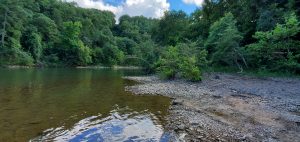Watersheds Need Local Stewardship
Alabama is proud of its rivers and streams and are featured on the Official State Seal of Alabama. Despite this pride, people struggle with the question, “Whose responsibility is it to protect our waterways when they belong to all of us?” The health of watersheds directly impacts people. Additionally, human behavior and design impacts watershed health. The Alabama Watershed Stewards (AWS) program at Auburn University uses a watershed approach to involve people in addressing local quality concerns. The AWS program offers state-wide educational trainings to the public. Additionally, AWS offers online trainings and resources as it strives to create the conditions for long-term change by building social infrastructure, localizing water quality issues, and providing tangible steps for improvement.
Watersheds and Watershed Management Planning
A watershed is a naturally defined area of land that determines how precipitation collects and drains water into a common basin (river, lake, or stream). Everyone lives in a watershed and each watershed is different. Pollution, erosion, and other activities that take place on the land can significantly impact water quality and ecological communities within the watershed. Watersheds are natural geographic boundaries in the landscape and can be a helpful and tangible way to frame and address local water quality concerns. Watersheds are classified in Hydrologic Unit Codes (HUC), which range in size and can be nested within one another.
Groups interested in maintaining and improving water quality at a watershed scale develop locally strategic Watershed Management Plans written for a specific HUC. These plans address water quality problems in a more holistic way. These plans assess potential causes of pollution and the prioritize restoration and protection strategies to address these problems.
Why Use Watershed Approach?
The Environmental Protection Agency defines a watershed approach as a coordinating framework for environmental management that focuses public and private sector efforts to address the highest priority problems within hydrologically-defined geographic areas, taking into consideration both ground and surface water flow. Making the connection between land use, human activities, and ecological impact on our shared natural resources can be a difficult task due to the complexity of these systems. Watershed planning can give local stakeholders more ownership over appropriate avenues for change by outlining the current state of the watershed, projected concerns, and by prioritizing future activities.
By using a watershed approach, the Alabama Watershed Stewards Program encourages citizens to take an active role in addressing local water quality concerns. Communities can use watershed management plans to help prioritize community activities, providing a tangible bite-sized approach to tackling the biggest areas of concern within a watershed.
Alabama Watershed Stewards
Alabama Watershed Stewards (AWS) is a statewide science-based educational program that is striving to bridge the gap between water quality education and citizen engagement. Housed under the Auburn University Water Resources Center, AWS receives funding from a Clean Water Act 319 grant through the Alabama Department of Environmental Management. The program promotes healthy watersheds by increasing understanding of water pollution while providing the knowledge and tools needed to prevent and resolve local water quality problems. AWS currently consists of in-person trainings across the state, on the ground workshops, professional trainings, an online course, and various online educational resources. Activities are led by the Auburn University Water Resources Center, (Alabama Cooperative Extension System Water Program in partnership with Alabama Water Watch) and various local partners. Over the next two years, expanded program offerings are possible thanks to additional funding received.
How the Program Works
Working with the Alabama Department of Environmental Management, AWS selects regions with impaired (polluted) waterways. These waterways fail to meet Clean Water Act 303 quality classification standards. For example, when a stream fails to meet state defined water quality standards classification due to nonpoint source pollutants, sediment, etc., opportunities exist for communities within that watershed to work together (often though the guiding framework of a watershed management plan) to address and remove the causes of the pollution.
In these select watersheds, AWS will host a one-day educational program open to the public that will educate citizens about watersheds and water issues, provide communities with the knowledge of how to protect and improve water quality and empower communities to help protect the quality of their watersheds.
Topics Covered
- Basics of watershed systems and how they function
- Watershed quality in Alabama
- Best management practices for pollution reduction
- Community involvement in watershed improvement projects
- How to find local water-resource related organizations and projects
Involvement Crucial
Participation in these trainings help build a robust social infrastructure that will make it easier to initiate and carry forward watershed projects. These trainings welcome Extension agents, water-resource organizations, and the general public as participants. In 2022 and 2023, AWS will also host additional Watershed Planning Workshops to enable citizen planning and engagement in developing and following watershed management plans.
The program offers a free online course available on a rolling basis to anyone including high school students. It also brings in experts to provide technical professional trainings that can have an outsized impact in the working environment. Examples include trainings on: Installing Bioretention Cells, Installing Permeable Pavement, Stormwater Wetlands, and Rain gardens.
Resources developed for this program are available on the ACES Webpage.
The Watershed Stewards program helps people understand the intricacies that impact land and water resources. It also connects individuals who want to make a meaningful impact on their watershed. To find out about upcoming events in the new year, follow the ACES Water Social Media account or contact stewards@auburn.edu to be added to the mailing list.
For information please contact Laura Bell, Outreach Programs Administrator.















